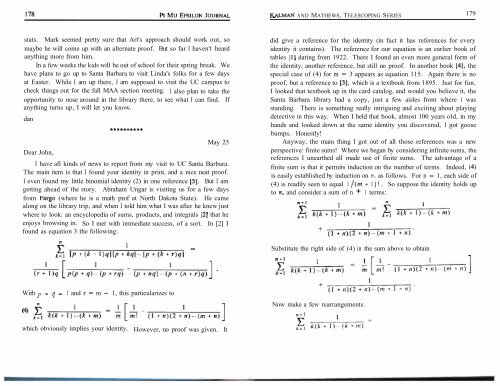Vol. 10 No 3 - Pi Mu Epsilon
Vol. 10 No 3 - Pi Mu Epsilon
Vol. 10 No 3 - Pi Mu Epsilon
- No tags were found...
You also want an ePaper? Increase the reach of your titles
YUMPU automatically turns print PDFs into web optimized ePapers that Google loves.
KALMAN AND MATHEWS, TELESCOPING SERIES 179stats. Mark seemed pretty sure that Art's approach should work out, somaybe he will come up with an alternate proof. But so far I haven't heardanything more from him.In a few weeks the kids will be out of school for their spring break. Wehave plans to go up to Santa Barbara to visit Linda's folks for a few daysat Easter. While I am up there, I am supposed to visit the UC campus tocheck things out for the fall MAA section meeting. I also plan to take theopportunity to nose around in the library there, to see what I can find. Ifanything turns up, I will let you know.danDear John,May 25I have all kinds of news to report from my visit to UC Santa Barbara.The main item is that I found your identity in print, and a nice neat proof.I even found my little binomial identity (2) in one reference [5]. But I amgetting ahead of the story. Abraham Ungar is visiting us for a few daysfrom Fargo (where he is a math prof at <strong>No</strong>rth Dakota State). He camealong on the library trip, and when I told him what I was after he knew justwhere to look: an encyclopedia of sums, products, and integrals [2] that heenjoys browsing in. So I met with immediate success, of a sort. In [2] Ifound as equation 3 the following:did give a reference for the identity (in fact it has references for everyidentity it contains). The reference for our equation is an earlier book oftables [l] dating from 1922. There I found an even more general form ofthe identity, another reference, but still no proof. In another book [4], thespecial case of (4) for m = 3 appears as equation 1 15. Again there is noproof, but a reference to [3], which is a textbook from 1895. Just for fun,I looked that textbook up in the card catalog, and would you believe it, theSanta Barbara library had a copy, just a few aisles from where 1 wasstanding. There is something really intriguing and exciting about playingdetective in this way. When I held that book, almost <strong>10</strong>0 years old, in myhands and looked down at the same identity you discovered, I got goosebumps. Honestly!Anyway, the main thing I got out of all those references was a newperspective: finite sums! Where we began by considering infinite sums, thereferences I unearthed all made use of finite sums. The advantage of afinite sum is that it permits induction on the number of terms. Indeed, (4)is easily established by induction on n, as follows. For n = 1, each side of(4) is readily seen to equal 1 /(m + 1 )! . So suppose the identity holds upto n, and consider a sum of n + 1 terms:Substitute the right side of (4) in the sum above to obtainWith p == q = 1 and r = m - 1, this particularizes to<strong>No</strong>w make a few rearrangements.which obviously implies your identity. However, no proof was given. It
















